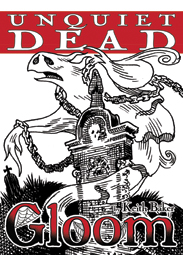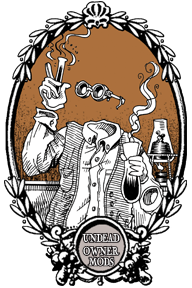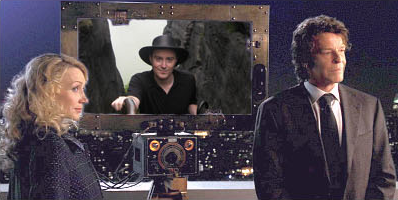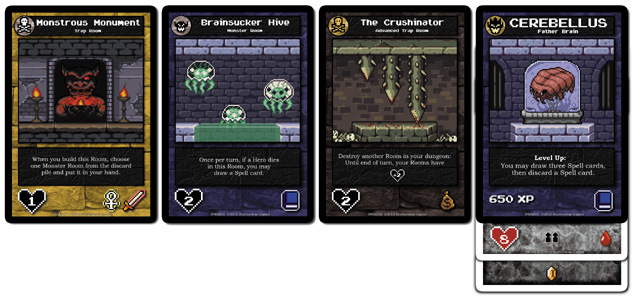In days to come I’ll be talking about GenCon, Gloom, and Phoenix. But it’s been a few months since I wrote anything about Eberron. When I started the Dragonmarks I focused on specific topics, and I wanted to get back to that. So today I’m talking about the Daelkyr and the Cults of the Dragon Below. As always, everything here is just my opinion. It may contradict present or future canon sources and is not official in any way. With that said…
Eberron has its fair share of apocalyptic villains. The Lords of Dust serve fiendish Overlords who ruled the world in the dawn of time and wait to be released to rule it again. The Dreaming Dark uses our dreams as tools to enslave us. Then there are the Daelkyr. Eight thousand years ago, the Daelkyr came through from the plane of madness, and by the time they were bound in Khyber they’d brought down the Empire of Dhakaan. Unlike the Overlords, the Daelkyr are still active in Khyber. You could go down into the underworld and meet one. Their stats in the 3.5 ECG don’t even seem that impressive, really. So what’s up with the Daelkyr? Why bother with them when you have the more powerful and ancient Lords of Dust around? What do they bring to a story?
First of all, what are the Daelkyr?
The Daelkyr are powerful entities from Xoriat, the plane of Madness. They aren’t the most powerful denizens of Xoriat; they are simply the mightiest to have shown any interest in other planes. They are immortal outsiders, not creatures of flesh and blood. The slightest touch of a daelkyr can sicken or warp organic creatures, and its mere presence can cause temporary madness. Peering into the mind of a Daelkyr can cause permanent insanity. This speaks to the fundamental difference between the Daelkyr and all those other forces: we don’t understand them. The others make sense to us. The Dreaming Dark wants to control the world because that’s the only way they can secure the survival of their culture. The Lords of Dust want to free their masters and restore their primal dominion over the world. The Daelkyr… we just don’t know. At the end of the day we don’t know what they want or how they intend to achieve it. We know what’s keeping them at bay – the seals created by the Gatekeepers – but we don’t know why the Daelkyr haven’t already broken those seals or what would happen if they did. Unlike the Overlords, the Daelkyr are free to move about in Khyber. They have armies of aberrations and cults scattered across the world. Why haven’t they taken more active measures to secure their release? Are the mightiest Daelkyr working together, or are they working at cross purposes? Why is it that their cults often follow completely different creeds and are quite often entirely unaware of one another? Again, at the end of the day, we don’t know. We know they are down in Khyber. We know the power they possess. But we don’t know what they want or what they are doing.
A common theory is that the Daelkyr aren’t actually soldiers or conquerors: they are scientists and artists. They don’t actually have any interest in ruling the world or in destroying it; they are simply interested in changing it. They took the goblins of Dhakaan and created dolgaunts, dolgrims, and dolgarrs from them and then sent those creatures back against the empire. It could be that this conflict was all they wanted… they didn’t actually CARE about who won, they simply wanted to watch the goblins fight these twisted mockeries of their own kind and see what impact that had. And in the end, it wasn’t the military force of the Daelkyr that destroyed the empire; it was the seeds of madness, the rivalries created, the erosion of faith in tradition, the cults, and all the myriad other long-term effects that brought down Dhakaan. The Daelkyr wounded the empire with brute force, but it was the infection over time that killed it… which may have been their goal all along.
Meanwhile, they DIDN’T make any sort of dolgaunt equivalent from orcs; instead they just spawned a host of cults that linger to this day. Yet many of those cults don’t directly revere or serve the Daelkyr themselves. Again, it seems like change was more their goal than destruction.
Part of the point here is that the release of a Daelkyr is not likely to be anywhere near as apocalyptic as the release of an Overlord. It’s something that would have dramatic effects on a region – but it could conceivably go unnoticed by the world at large for years. Heck, there could be a free Daelkyr at large right now.
Let’s look at a few questions.
Was the daelkyr’s humanoid appearance always part of the concept?
The Daelkyr are often depicted as attractive, androgynous humanoids clad in organic armor. Some wonder “why do they look human, when they originally fought goblins?” In my opinion, this appearance doesn’t remotely reflect the true nature of the Daelkyr; it is simply something the human brain puts together to make some sort of sense of what it’s facing. As such, a goblin might see some sort of handsome goblinoid wearing the skins of its enemies, and a warforged might see an imposing construct clad in the rusting remnants of other warforged. I’m inspired by this image of Galactus from back in the day…
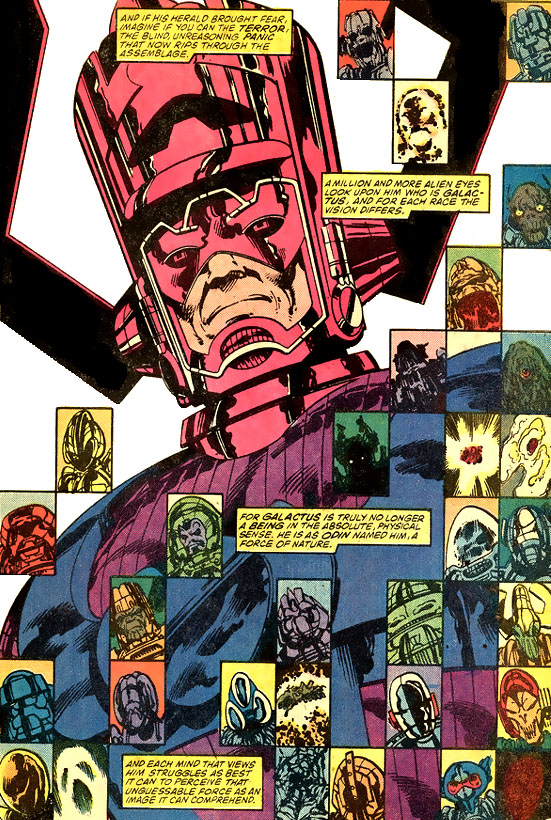 Bear in mind that a Daelkyr can cause confusion at will – which is to say, it can break your mind just by thinking about you. Given that, the idea that different people may see Daelkyr differently is a fairly minor thing.
Bear in mind that a Daelkyr can cause confusion at will – which is to say, it can break your mind just by thinking about you. Given that, the idea that different people may see Daelkyr differently is a fairly minor thing.
With that said, I also believe that different named Daelkyr will have unique appearances. We’ve shown Kyrzin (Prince of Slime) as a vaguely humanoid slime with human limbs embedded in it. I’d expect Belashyrra (Lord of Eyes) to be associated with eyes. With that said, I WOULD be more inclined to make Belashyrra some sort of humanoid as opposed to, say, a giant beholder. Daelkyr do carry symbionts designed to be used by humanoids. They may not look HUMAN, but I think they manifest in a humanoid shape.
How high is the Daelkyr threat level compared to the overlords?
As described above, I don’t consider the Daelkyr to be as IMMEDIATE an apocalyptic threat as the Overlords. The release of the Daelkyr won’t mean instant devastation; the main thing is that once those seals are broken, you may never be able to fix them again. The conflict between the Dhakaani and the Daelkyr lasted for centuries, and I wouldn’t expect things to be different now. A released Daelkyr wouldn’t destroy the world… but it WOULD start changing the region around it, and might eventually fling an army of aberrations at the country next door, spread plagues or waves of madness, or otherwise do things that could harm tens of thousands of people or break the existing balance of power.
(The Daelkyr) are a little difficult to use in a campaign as the main villains because they are not as strong, manipulative, or great in number as the overlords…
I’ll touch on influence in a moment, but speaking to “strength”, there’s a few things. First, bear in mind that a Daelkyr should never be found alone. They create monsters, madness, and bizarre diseases as a hobby, and have had eight thousand years to indulge in this. Belashyrra has a battalion of beholders, not to mention dolgaunts, mind flayers, and anything else you care to create. And if you want to say that Belashyrra has bred an army of 100,000 beholders and has it sitting under Sharn right now… than he does.
Second: Don’t be limited by the stats that are presented. First of all, Daelkyr are like demon princes. All of the major ones – Belashyrra, Kyrzin, Dyrrn the Corruptor, Orlassk – should be unique individuals with their own powers. Second, more than any other creature in D&D, Daelkyr should break the rules. The fundamental rule of the Daelkyr is that we don’t understand them. As powerful as the Overlords are, they are part of Eberron. They are embodiments of concepts that shape our world. The Daelkyr are something else entirely. They don’t belong here. Having magic or other fundamental rules warp around them is entirely in keeping with them as a concept.
Aside from the fact that direct magical effects may not work as you expect, feel free to assign powers to Daelkyr that simply have no grounding in standard mechanics. For example, it’s said that Belashyrra can see through anyone’s eyes. Maybe that’s exaggerated; maybe it’s the literal truth. Maybe he can blind anyone he wants – anywhere, anytime – or swap your sight with someone else, so suddenly you’re seeing the world through the eyes of an orc shaman in the Shadow Marches. Meanwhile, the Marchers say that Kyrzin has influence over anyone who’s suffering from excessive mucus. Maybe a faerie tale… maybe not. Again, the key with the Daelkyr is that we DON’T KNOW. This is enhanced by their alien attitude and uncertain goals. If the Dreaming Dark could see through everyone’s eyes, they would use it to further their known agenda. Belashyrra COULD do lots of useful things with this gift, and simply chooses not to. Why?
How much day-to-day influence do the Daelkyr actually have, and why? As opposed to mere personal might?
This ties to the question above: We don’t know, because we don’t know what they want, and we don’t know what they are capable of. It’s possible that anyone who’s got a cold is an unwitting agent of Kyrzin, and that anyone who’s got eyes is an unwitting spy for Belashyrra. Beyond this, ANYONE WHO’S CRAZY MAY BE CRAZY BECAUSE OF THEM. And “crazy” is a very broad term, as I’ll discuss when we get to the cults.
Furthermore, the Daelkyr can always create new things we’ve never seen before. Someone asked if the Daelkyr could actually be responsible for Dragonmarks. Why not? The Daelkyr specialize in creating and modifying lifeforms. They get to break the rules. They could have created the dragonmarks as a weird living way of embodying the Prophecy that the dragons and fiends still can’t really understand… and the aberrant dragonmarks are a weird variant of that experiment. This could relate to the Cult project in my City of Towers novel… and could mean that they could create new dragonmarks, move them onto new races, etc.
So the short form is “How much influence do they have? Well, how much influence do you WANT them to have?” The key here is that a campaign in which the Daelkyr are the villains should feel entirely different from one dealing with the Dreaming Dark or the Lords of Dust. it doesn’t HAVE to revolve around the release of a Daelkyr; it could revolve around the emergence of a new sort of dragonmark, an attack by an army of previously unknown aberrations, the killing spree of a single bizarre serial killer, the spread of a horrible plague… or all of these things stitched together in a strange and unexpected tapestry.
I find that horror is difficult to pull off without visual aid.
This needs to be the subject of its own blog post, but the trick here is that the gooey symbionts are really the least frightening thing about the Daelkyr. What’s far more frightening is the fact that you don’t know what they are, what they want, or what they can do to you. Say you are looking in the mirror one morning, and just for a moment you see Belashyrra looking back at you. What does it mean? Perhaps a small eye-shaped dragonmark-like tattoo then appears on your hand. What does it mean? Perhaps you start having telepathic intuitions about the motives of people around you. They save you from an ambush, but… what does it mean? Then you hear about another fellow who had the same mark, and who ended up killing his friends and family and disappearing… and no one knows why. The fear here isn’t VISUAL at all; it’s the fact that you are touched by something you don’t understand, you don’t know why, you don’t know what to do about it, and you don’t know what’s going to happen next.
Similarly, when dealing with the powers of the Daelkyr, think about what they actually are and what can make them horrifying. A Daelkyr can use confusion at will. But what does it mean to be “confused”? Does it take you back to the most horrible time in your life when you were surrounded by enemies? Does it make you watch helplessly while your body blunders around on its own? When it uses Feeblemind, it is stripping away your ability to speak, to understand language, to do anything you once could do… the idea of that, of being conscious but unable to communicate, unable to remember how to use a sword or cast a spell… that’s more horrifying to me than any gooey monster. The horror of the Daelkyr is the things you CAN’T fight with a sword… and the fear of what might be coming next.
Why don’t the Daelkyr team up and free themselves, like, right now?
I’ve answered this above, but I’ll reiterate it here… THIS IS A QUESTION DAELKYR SCHOLARS HAVE BEEN ASKING FOR CENTURIES. It may be because they don’t care about being imprisoned. Perhaps it’s because they are immortal and know that the seals will all break in 999 YK when Xoriat finally becomes coterminous again, and they don’t mind waiting. Perhaps it’s because they can do everything they want to do WHILE being imprisoned. Or perhaps it’s because they are engaged in a series of feuds so esoteric and strange that we don’t even know they are going on!
Was the Undying Court ambivalent to the daelkyr invasion of the Dhakaani empire? Or busy with some other pressing business at the time?
Short answer: The power of the Undying Court is concentrated in Aerenal. They undoubtedly took action to defend Aerenal from the incursion. The Dhakaani had already fought the Tairnadal and driven them from Khorvaire, so there was no love between elf and goblin; even if the Court had the power to help Dhakaan, it’s not much of a surprise that they chose to focus on their own defense.
Is there any evidence to support the claim that the daelkyr were refugees seeking asylum in Eberron and that the Dhakaani empire was the one to initiate hostilities, forcing the daelkyr to respond in self defense?
None at all. You may be thinking of the theory that the Quori were refugees seeking asylum in Eberron when they were attacked by the Giants; there’s a fair amount of evidence suggesting that, and more important, neither culture survived to the present day, so there’s no way to verify it. Meanwhile, we have the Gatekeepers, Heirs of Dhakaan, and the Daelkyr themselves as multiple living threads attesting to the hostile intent and actions of the Daelkyr. With that said, it can be argued that the Daelkyr don’t consider collapsing civilizations and warping creatures into new forms to be a hostile act.
Are there Gatekeepers corrupted by the Daelkyr?
Certainly. “Gatekeepers corrupted by the Daelkyr” is an entirely valid foundation for a Cult of the Dragon Below. Consider the link above.
The question about the Undying Court’s reaction (or absence thereof) to the Daelkyr invasion of the Dhakaani Empire reminds me of one that’s been bugging me for some time. Did the Daelkyr only target Khorvaire for their invasion – and within Khorvaire, only the south-west in and around the Shadow Marches and some of the border areas? I’ve read that the chokers may have been formed from halflings, so strikes into the Talenta Plains may have happened – but what of Xen’drik, Argonessen, or Sarlona – who, in the absence of Gatekeepers, would have been defenseless?
As far as has been mentioned in canon, the Xoriat incursion was limited to Khorvaire; notably, there’s no mention of it having targeted Sarlona at all, and even the problems of the Umbragen came after the Daelkyr were trapped in Khyber. They struck across Khorvaire; in addition to the Talenta Plains example, they also wiped out the Dwarven civilization that once existed below the Ironroot Mountains. Looking to the question of why they’d do this when there were other, easier targets… the Shadow Marches has an unusually large number of manifest zones to Xoriat, and this is part of what made the incursion possible in the first place. Bear in mind that there were no Gatekeepers in Khrovaire when the Daelkyr attacked; they were formed in response to the incursion, and if the Daelkyr had attacked Sarlona Vvaraak would have gone there. But most of all, bear in mind that the Daelkyr weren’t looking for a defenseless place. They weren’t trying to claim territory; they were (as best as we can tell) interested in transforming the world. Today, Dhakaan has fallen, and we have dolgaunts and dolgrims, derro beneath the mountains, cults of the Dragon Below, chokers in the shadows… it’s not clear that they are unsatisfied with the outcome. As noted in the other Dragonmark, they don’t seem to be working very hard to break the seals. Having dropped seeds of madness into Eberron, they may simply be watching as those seeds spread, waiting until the time is right for the next phase.
Now let’s move from the Daelkyr to the Cults of the Dragon Below. A few people asked variations of the same question…
“Why would anyone find the Cults attractive, given their obviously ‘wrong’ nature?”
Because if you’re in the cult, it doesn’t seem “wrong.” Imagine that you wake up one morning with the sudden realization that you are the reincarnated soul of King Arthur, and that you have to save the world from the new Modred. You have the ability to see the auras of the other Knights of the Round Table, and so you start gathering them together – and they in turn see you as their king. You even find Merlin dwelling in the sewers, and he whispers to you of your missions. This is a perfect model for a Cult of the Dragon Below. The cultists don’t see that “Merlin” is a mind flayer, or that “Excalibur” is a bizarre sword formed from muscle and bone; they see it as the most perfect sword ever formed. Because they are insane. It may be a extremely subtle madness, and “King Arthur” may be a brilliant and charismatic leader. But he’s still convinced that he IS King Arthur, when in fact he’s just some random soldier holding a gooey sword and talking with a mind flayer. To you as an outsider it seems “wrong.” For him, it is his destiny and a quest that will determine the fate of the world.
This is why Cults rarely work together. They are driven by delusions and don’t necessarily share any sort of common creed. One cult embraces the aberration and sees symbionts as a way to improve on weak flesh; another doesn’t even see symbionts AS symbionts, instead seeing them as amazing glittering treasures.
The Cults seem to be an avenue for the desperate and insane, why would a rational person of means who join the Cults?
See above. “King Arthur” could be one of the greatest generals of the Five Nations, in charge of thousands of troops. He could also be an amazing strategist and extremely rational person… except for the part where he thinks he’s King Arthur. Just because you’re insane doesn’t mean you’re desperate, and “insane” can mean MANY different things. Poor and desperate people might turn to a cult willingly because they see it as a source of power or a means of survival. But madness can strike anyone, anywhere. And that’s not even getting into the fact that Kyrzin could technically spread a cult by using the common cold.
Why do people join the Cults? It seems like their core tenet is that everyone’s going to die, but the faithful die faster.
Game mechanics sort of imply all cults are some what uniform. How much variation is there? Can they hate each other?
Blood of Vol seems like a morally-ambiguous church (at least in terms of followers) -Why was Dragon Below not written similar?
I want to address these together. I’ve already talked about the fact that a Cult can appear anywhere, anytime, and that their creeds can vary dramatically. However, we also have the established, long-term cults that you find in places like the Shadow Marches. There’s a few sources on these:
“Touched By Madness” is an article in Dragon Magazine (back when it was a magazine) that discusses a variety of cults.
The Gibbering Cults are described in this article on the Daelkyr Kyrzin. Gibbering Cults cultivate gibbering beasts, and when a member of the cult grows sick or elderly, they feed them to the family beast. They believe that the soul lives on in the beast, and that they can hear its wisdom when they listen to the beast. Beyond this, they aren’t innately evil. They aren’t going to feed YOU to the family beast, because you don’t deserve it. Some gibbering families may be crazed killers; others might seem just like you and me – provided you stay out of the basement. Really, it’s not that different from the Undying Court.
The Inner Sun cults are mentioned in this Eye on Eberron article. Here’s a quote:
Collectively, the Cults of the Dragon Below are anything but monolithic. Creeds vary wildly from one group to another, and cults spring up spontaneously; sometimes a madman has a vision that infects the minds of those around him. A few common threads of thought, however, appear in similar forms across cult lines. One shared precept is that the world is an imperfect place. Khyber sought to perfect it—to eliminate pain, suffering, death and all other woes—but the other dragons turned on her, and when Eberron couldn’t defeat Khyber, she trapped her.
The second element of this credo concerns the realm of the Inner Sun. It is the belief that a paradise exists within Khyber, a place where people can escape the suffering of everyday life. Most of the cults that subscribe to this belief consider the Vale of the Inner Sun to be a place that can be reached only after death, often coupled with the requirement that one must earn passage to the vale by spilling the blood of worthy enemies. This perceived duty has been the motivation behind the acts of many murderers and vicious Marcher clans.
Many of these hereditary cults aren’t LOOKING for new members. You join one by being born into it, and it makes sense to you because that’s how life has always been. But you could certainly play a half-orc barbarian raised in an Inner Sun cult who’s joined the party looking to kill enough worthy foes to earn his way to the Vale… and he could end up being a great and noble hero, despite this belief.
How do cults operate in Sharn, and what arm of law enforcement rides herd on them?
The point of the Cults is that it’s hard to monitor them because a new one can pop up anywhere and the lack of a common creed makes it difficult to identify. So the Blackened Book is investigating the weird summonings going on in Ashblack, while the Citadel is looking into this whole King Arthur thing, and none of them have noticed the gibbering family living in Fallen.
How would you suggest using a Cult of the Dragon Below as allies to the PCs instead of antagonists?
Don’t make it obvious that they ARE a Cult of the Dragon Below. Again, that Gibbering family may be fine, decent, helpful people who just happen to be getting ready to feed grandma to the gibbering mouther in the basement. Or try this: there’s a cult that is convinced that they must steel their minds and souls to face a terrible threat. They believe that there are CREATURES LIVING IN OUR DREAMS and trying to control us. They are actually going around assassinating people because “Their minds have been consumed by dream-monsters”; they also have some awesome monk disciplines tied to this training. The leader of the cult is, in fact, a mind flayer, but he doesn’t eat anyone’s brains; instead, he “consumes their fears”, a process that does actually seem to strengthen will without harmful side effects; he also helps them operate without sleeping, to avoid the dream monsters, and it’s his training that helps them spot the “corrupted”. He tells the adventurers that he bears their kind no ill will and simply seeks to keep the dream-monsters from consuming the mind of the world. SO… is this all on the level? Is the mind flayer actually training people to oppose the Quori? Are they actually assassinating mind seeds? Or are they in fact just totally misled and crazy, assassinating entirely innocent people?
When did the cults start to take hold? Were there giants and elves/drow that venerated the Dragon Below or did worship of the horrors get footing only after the Xen’drik cataclysm?
Well, cults that literally worship KHYBER have existed long before the Xoriat Incursion. as for Xoriat-inspired cults, we haven’t mentioned any specifically, but there’s no reason some couldn’t have existed before the arrival of the Daelkyr; in fact, it would be logical for there to have been a cult in the Dhakaani era that laid the groundwork for the arrival of the Daelkyr in the first place.
If the Gatekeepers didn’t stop the Daelkyr invasion, how would it have changed Eberron as a game system? Would it have been akin to, say something like Dark Sun or Ravenloft?
Sure, or Gamma World. The ultimate goal of the Daelkyr is to reshape the world, and once they are done they’d likely move on to another world (as noted in the suggestion that the Gith are survivors from another world claimed by the Daelkyr). It would be a world filled with aberrations, madness, strange powers, and the like – both flora and fauna would definitely be affected.
Dolgrim, Dolgaunts, etc, are obviously the goblinoid aberrations – if I wanted to create other races’ aberrations, what is the guiding principle regarding a “corrupt” race? Dolgrims and Dolgaunts don’t seem much like goblins and hobgoblins except in size.
There is no “guiding principle”. It’s going to depend entirely on what daelkyr you’re dealing with. Kyrzin likes slimes and disease. Belashyrra has a fondness for eyes. Orlassk likes stone and petrification. Dyrrn just likes corruption in any form, mental or physical. As noted above, DRAGONMARKS could be the result of Daelkyr “corruption”. A Daelkyr may choose to create something designed to inspire fear or horror in others… or it may design something strange and bizarre that it simply finds pleasing or necessary for its goals. The Dols were created to serve as soldiers and unleashed on the Dhakaani. They were designed to horrify the Dhakaani and to be effective soldiers. Dragonmarked humans could have been engineered as a way to control the Prophecy (or they could have nothing to do with the Daelkyr – don’t get me wrong). Any form of manipulation is appropriate.
What part, if any, do the Lords Of Dust play in the formation of the cults?
What part do you want them to play? If it furthers the goals of their Overlord, a Lord of Dust might well set a cult in motion. The Daelkyr are weaker than the Overlords, and certain Overlords (such as the Voice in the Darkness) don’t see the Daelkyr’s actions as any sort of threat to their goals. Beyond this, of course, there are some “Cults of the Dragon Below” that are entirely dedicated to the Overlords as opposed to being influenced by the Daelkyr.
Why did Vvaraak teach the orcs to fight the daelkyr? Wasn’t Darguun militarily the more capable power? Will of the Prophecy?
It could have been driven by the Prophecy. it could be that the Daelkyr already had too much influence over the Dhakaani for Vvaraak to reach them. I’m inclined to say that the Dhakaani were simply too entrenched in their own cultural traditions to abandon them and embrace some bizarre tree-hugging dragon’s weird religion. The Dhakaani knew exactly how to handle the situation: steel, military discipline, and the magic of the Duur’kala. If some barbarian orc wants to go pray to moss or the “great earth dragon” – frankly, that sounds like the exact sort of madness our enemy is spreading.
Since the Silver Flame opposes supernatural threats, does the Church of the SF have alliances with gatekeepers against Daelkyr?
The Gatekeepers are almost entirely unknown outside of the Shadow Marches, and given some of the CotSF’s issues with Droaam aren’t entirely trusting of the Church; overzealous followers of the Pure Flame might well see orc mystics as a problem, not a solution. With that said, the Church of the Silver Flame seeks to protect the innocent from all supernatural threats, and the Daelkyr are certainly a supernatural threat. So I think that Jaela would find common ground with Maagrim’Torrn if they ever met, and I think most true followers of the Flame would help Gatekeepers if they faced aberrations together, but Thrane and the Shadow Marches are far away.
Can an exorcist of the SF repel the Daelkyr and Xoriat beings?
An exorcist’s Flame of Censure affects “outsiders with the evil subtype”. As a result, it WILL work against a Daelkyr – an evil outsider – but won’t work against a dolgaunt. Aberrations aren’t really the province of the Flame; it’s used to dealing with fiends, undead, and the like, and the point of aberrations is that they are fundamentally more alien than even a demon; aberrations are the things we don’t understand, things that don’t follow natural law.


